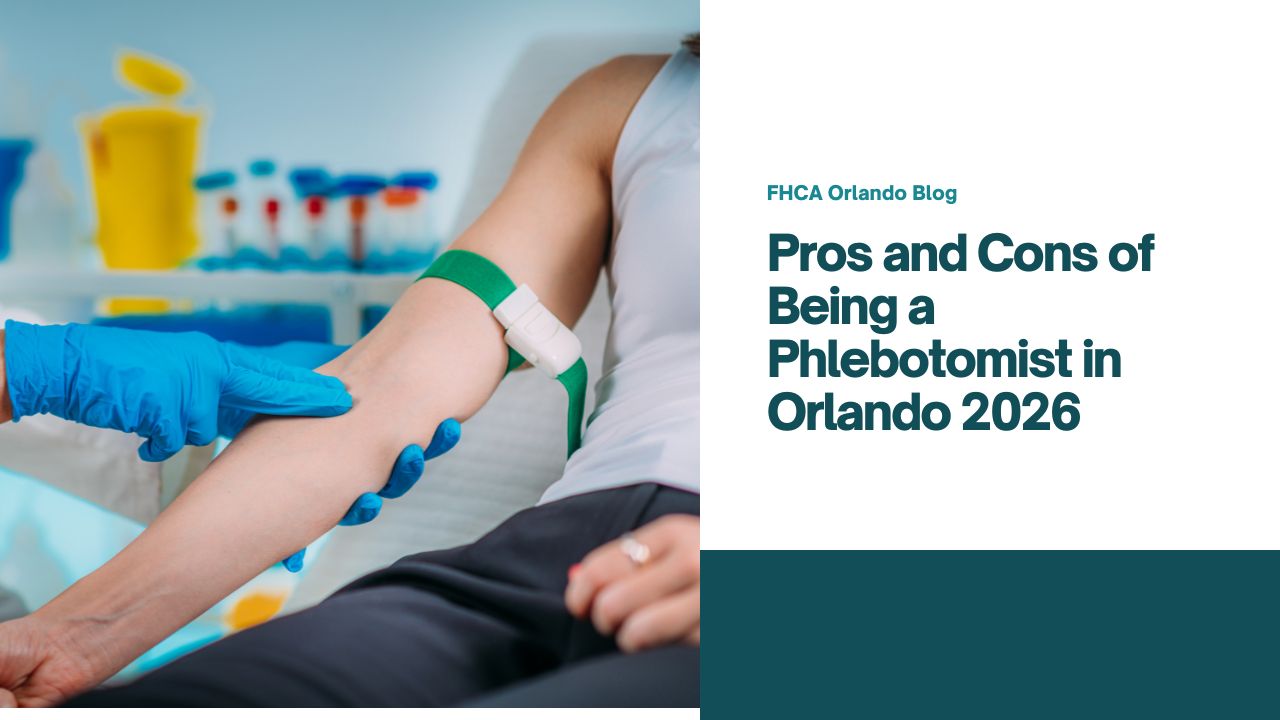Top Phlebotomy Interview Questions
Aug 26, 2024
As a phlebotomist, you are often the first point of contact for patients in a clinical setting, making your role pivotal in the healthcare process. To help you prepare for your next interview, we've compiled a comprehensive guide to the most common phlebotomy interview questions.
If you're looking to advance or wondering how to get phlebotomy experience, this guide will also provide insights and training to help you demonstrate your expertise and stand out as a top candidate
This guide will equip you with the insights and training you need to demonstrate your expertise and stand out as a top candidate. If you're just starting out, be sure to check out our guide on how to be a phlebotomist.
Table of Contents
- General phlebotomy questions
- Phlebotomy technical skills questions
- Behavioral and situational questions
- Tips for answering phlebotomy interview questions

General phlebotomy questions
In any phlebotomy interview, you'll encounter questions that explore your general knowledge and experience in the field. These questions and answers are designed to assess your foundational understanding and your ability to apply it in real-world scenarios.
For those interested in working with children, understanding how to become a pediatric phlebotomist can be valuable as it requires unique skills and a compassionate approach. If you're curious about the various career paths available, explore where a phlebotomist can work for more insights.
If you're considering a broader healthcare role, you might want to compare being a patient care technician vs. a phlebotomist.
Example Answer:
"My experience in patient care spans several years, during which I've worked in various healthcare settings, including hospitals, clinics, and outpatient facilities. I've always prioritized creating a calming environment for patients, especially those who are anxious or fearful.
For example, I once worked with a pediatric patient who was extremely afraid of needles. I used a gentle tone, explained the process step-by-step, and allowed them to ask questions, which helped ease their anxiety. This approach has been effective in building trust and ensuring a positive experience for all patients."
Example Answer:
"When dealing with patients who are afraid of needles, I start by acknowledging their fear and reassuring them that their feelings are valid. I then explain the procedure in simple terms to demystify the process and use distraction techniques, such as engaging them in conversation or asking them to focus on their breathing.
In one instance, I had a patient who was very nervous, so I offered a stress ball to squeeze and guided them through deep breathing exercises. By the end, they were much calmer, and the blood draw went smoothly."
Example Answer:
"I ensure accuracy and precision in blood collection by meticulously following standard protocols. This includes verifying patient information, double-checking orders, and properly labeling specimens immediately after collection. I always use the correct equipment and technique for each patient, depending on their specific needs.
Additionally, I use a checklist to confirm each step of the process is completed accurately. For example, when performing venipunctures, I consistently use the same careful method to ensure the sample's integrity is maintained."
Example Answer:
"I am well-versed in bloodborne pathogens, such as HIV, hepatitis B, and hepatitis C, and the necessary precautions to prevent their spread.
I always wear appropriate personal protective equipment (PPE), such as gloves and face shields, and strictly follow protocols for handling sharps and disposing of contaminated materials.
I also regularly sanitize my workspace and practice proper hand hygiene. In a previous role, I participated in a training program that further solidified my understanding of infection control and safety procedures."
If you're wondering about the challenges in the field, you might want to explore how hard it is to be a phlebotomist.
Example Answer:
"Once, I mistakenly labeled a specimen with the wrong patient's information. I immediately realized the error before the sample was processed and promptly informed my supervisor.
I followed the protocol for correcting such mistakes, including documenting the incident and notifying the lab team to discard the incorrect specimen.
I then retook the sample, ensuring it was correctly labeled. From that experience, I learned the importance of double-checking all patient details and implemented a personal verification routine to prevent future errors."
Example Answer:
"The chain of custody is a documentation process that tracks the collection, handling, and storage of a specimen from the point of collection to its delivery to the lab. This process ensures the sample's integrity, especially in legal or forensic cases.
I maintain the chain of custody by accurately labeling each specimen, completing all necessary forms, and ensuring that every transfer of the sample is documented and witnessed if required. I also store specimens securely to prevent tampering or contamination."
Continuing Education Courses for Phlebotomy
Phlebotomy technical skills questions
Technical skills are at the core of phlebotomy. Interviewers will ask questions that delve into your technical proficiency, ensuring that you possess the necessary skills to perform your duties effectively and safely.
Familiarity with phlebotomy medical terminology can also demonstrate your competence, as understanding specialized terms helps ensure clear communication and precise execution in clinical settings To brush up on the essential skills, you can review skills needed to be a phlebotomist.
Example Answer:
"The steps involved in a venipuncture procedure start with verifying the patient's identity and confirming the test order. I then gather all necessary equipment, such as gloves, a tourniquet, antiseptic wipes, needles, and collection tubes. After applying the tourniquet and locating a suitable vein,
I clean the site with an antiseptic. Once the needle is inserted into the vein at the correct angle, I collect the required amount of blood in the appropriate tubes. After removing the needle, I apply pressure to the site with gauze and secure it with a bandage.
Finally, I label the specimens correctly and ensure the patient is comfortable before proceeding with the next steps."
Example Answer:
"I select the appropriate equipment based on several factors, such as the patient's age, vein condition, and the type of test required. For example, I might use a butterfly needle for patients with small or fragile veins or a straight needle for those with more prominent veins.
The choice of collection tube depends on the tests ordered; for instance, I use EDTA tubes for hematology tests and serum separator tubes for chemistry panels. My priority is always to choose equipment that ensures a safe and effective draw with minimal discomfort for the patient."
Example Answer:
"Some common complications during blood draws include hematomas, fainting, or excessive bleeding. I monitor patients closely for signs like swelling, bruising, or discomfort, which could indicate a hematoma.
If a patient shows signs of fainting, such as sweating or becoming pale, I immediately stop the procedure, help them into a lying or sitting position, and provide a cool cloth or drink of water.
In the case of excessive bleeding, I apply pressure to the site and follow the necessary protocols to ensure patient safety."
Example Answer:
"There are several types of blood specimens, each used for different tests. Whole blood is typically used for complete blood counts (CBC) and can provide a full picture of a patient's health.
Plasma, obtained by centrifuging blood treated with an anticoagulant, is used for coagulation studies and certain metabolic tests. Serum, which is collected after allowing the blood to clot and then centrifuging, is used for chemistry panels and serology tests.
Understanding these differences is crucial for accurate testing and diagnosis."
Behavioral and situational questions
Behavioral and situational questions are designed job interview, to assess how you handle challenges in the workplace. These questions often explore your soft skills, such as communication, teamwork, and problem-solving.
Example Answer:
"I handle stress by staying organized and maintaining a calm demeanor. I prioritize my tasks and ensure I have a clear plan for each day.
During particularly stressful situations, such as high patient volume or unexpected emergencies, I focus on my breathing and remind myself to take one step at a time.
I also find that communicating openly with my team helps alleviate pressure, as we can support each other to manage the workload effectively."
Example Answer:
"I believe effective teamwork relies on clear communication, mutual respect, and a willingness to support one another.
In my previous role, I worked closely with nurses, lab technicians, and other healthcare professionals to ensure smooth patient care. I always communicate openly about patient needs and any potential challenges.
I also make an effort to listen actively to my colleagues and contribute positively to team discussions and problem-solving sessions."
Example Answer:
"I once had a patient who was very anxious about getting their blood drawn. They were visibly upset and initially refused to have the procedure done.
I calmly introduced myself, explained the process in simple terms, and reassured them that they could take all the time they needed. I also suggested they focus on a point on the wall and think about a pleasant memory.
By being patient and empathetic, I was able to gain their trust, and the procedure went smoothly."
Example Answer:
"Maintaining patient confidentiality is critical in healthcare. I strictly follow HIPAA regulations and ensure that all patient information is securely stored and only shared with authorized personnel.
I also make sure to discuss sensitive information in private areas and never leave patient records unattended.
In my daily practice, I am always conscious of protecting patient privacy, whether in conversation or documentation."
Tips for answering phlebotomy interview questions
When you´re preparing for your phlebotomy interview, it's important to focus on both your technical skills and your ability to provide compassionate patient care. Review common procedures, refresh your knowledge on safety protocols.
Be ready to discuss specific experiences that demonstrate your skills, and practice articulating your responses confidently. It’s about presenting yourself as a well-rounded candidate who can balance technical skills with compassionate patient care. Here are some tips to help you stand out in your interview:
Before you step into the interview, familiarize yourself with the key skills and qualities a phlebotomist should possess.
This includes knowledge of venipuncture techniques, an understanding of safety protocols (like handling bloodborne pathogens), and excellent communication skills.
Make sure you can articulate these skills confidently, providing examples from your experience that demonstrate your competence.
Phlebotomy is not just about technical expertise—it also requires a high level of emotional intelligence. Highlight your ability to empathize with patients, especially those who are nervous or afraid of needles.
Discuss how you handle difficult patient interactions, manage stress, and work effectively as part of a healthcare team.
Use specific examples to demonstrate your soft skills, such as a time when you successfully calmed a fearful patient or collaborated with colleagues to solve a problem.
Prepare for behavioral and situational questions by using the STAR method (Situation, Task, Action, Result). This approach helps you structure your responses to clearly convey your experience and problem-solving abilities.
For example, if asked about a time you made a mistake, describe the situation, what you were tasked with, the actions you took to rectify the error, and the positive outcome or lesson learned.
Interviewers appreciate candidates who can provide concrete examples of their work. Be prepared to discuss specific experiences where you demonstrated critical skills.
This could include how you handled a difficult blood draw, managed multiple tasks in a high-pressure environment, or implemented a new safety protocol that improved efficiency.
Healthcare is a constantly evolving field, and showing your commitment to ongoing education can set you apart.
Mention any continuing education units (CEUs) you’ve completed or are planning to pursue, especially those related to phlebotomy or other relevant healthcare areas.
This shows that you’re dedicated to staying current with best practices and advancing your skills.









